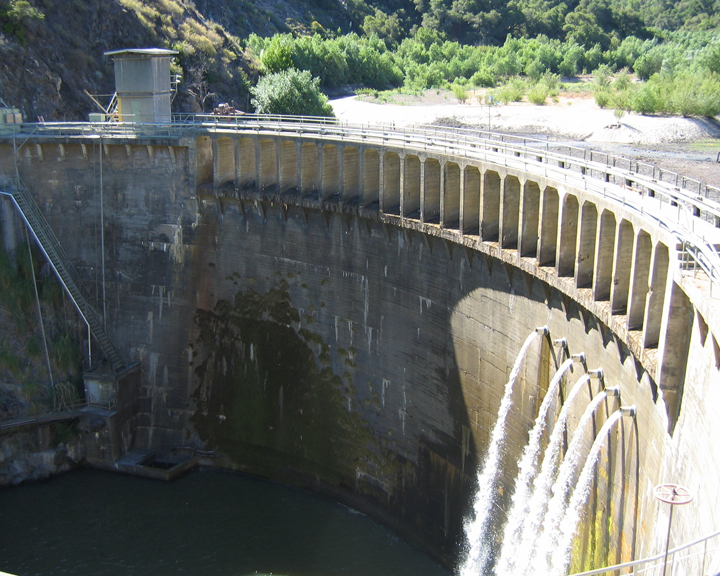
Photo courtesy of http://www.sanclementedamremoval.org/
San Clemente Dam, a 106-foot-tall dam on the Carmel River in the northern portion of Los Padres National Forest in Monterey County, is scheduled to be fully removed by the end of this year, which would make it the largest dam removed in California history. The dam, originally built in 1921, was deemed seismically unsafe in 1992 due to the large amount of sediment that had built up in the reservoir. While reinforcing the dam would have alleviated the safety concern, scientists found that complete dam removal to be the preferred alternative. This preferred alternative will not only prove to be a long term solution to public safety, but it will restore the natural sediment flow through the river and to the ocean, and it would aid in the recovery of steelhead trout by providing access to over 25 miles of spawning and rearing habitat.
Additionally, there will be no change to the water supply available to Monterey Peninsula residents as a result of removing the dam. The primary purpose of the San Clemente Dam has been to serve as a diversion point for Carmel River water. The San Clemente Dam reservoir is now over 95% full of sediment which has greatly impaired its ability to continue to function as a diversion point. Currently, all water supplies from the Carmel River are diverted from groundwater wells situated along the river that pump from the alluvial aquifer. Furthermore, San Clemente Dam has never provided any flood control, and its removal will not affect the volume or timing of flood flows on the river. The project team has completed sediment transport and flood modeling studies to verify that removal of the dam will not exacerbate the existing downstream flooding problems.
 However, with 2.5 million cubic yards (almost the volume of two Empire State Buildings) of sediment held behind the dam, simply removing the structure would create substantial flooding risks during high rain years. Luckily, San Clemente Dam is located at the confluence of the Carmel River and San Clemente Creek and the two watersheds above are separated by a narrow ridge. The majority of the accumulated sediment is on the Carmel River portion of the dam. Therefore engineers planned to reroute a half mile portion the Carmel River into the San Clemente Creek and use the abandoned stretch of the Carmel River as a permanent sediment stockpile. Through this approach, the engineers were able to significantly reduce costs by substantially decreasing the amount of sediment that would need to be moved (which is now only approximately 380,000 cubic yards). The new section of river will include a series of pools fashioned out of concrete sourced from the condemned dam, providing quality habitat to endangered steelhead trout and California red-legged frogs. In addition, California American Water is donating 928 acres of property around the dam to the BLM, which is working with the Monterey Peninsula Regional Park District to develop recreational trails for use by the public.
However, with 2.5 million cubic yards (almost the volume of two Empire State Buildings) of sediment held behind the dam, simply removing the structure would create substantial flooding risks during high rain years. Luckily, San Clemente Dam is located at the confluence of the Carmel River and San Clemente Creek and the two watersheds above are separated by a narrow ridge. The majority of the accumulated sediment is on the Carmel River portion of the dam. Therefore engineers planned to reroute a half mile portion the Carmel River into the San Clemente Creek and use the abandoned stretch of the Carmel River as a permanent sediment stockpile. Through this approach, the engineers were able to significantly reduce costs by substantially decreasing the amount of sediment that would need to be moved (which is now only approximately 380,000 cubic yards). The new section of river will include a series of pools fashioned out of concrete sourced from the condemned dam, providing quality habitat to endangered steelhead trout and California red-legged frogs. In addition, California American Water is donating 928 acres of property around the dam to the BLM, which is working with the Monterey Peninsula Regional Park District to develop recreational trails for use by the public.
Instead of going out with one big bang (much like this from 2014’s DamNation), the San Clemente Dam will be removed over the course of four to six weeks from August to September of this year. Afterwards the dam removal team will begin habitat restoration to improve fish passage and reconstruct the riparian corridor. The project is scheduled to be completely finished by the end of 2016.
For more information and updates, visit the project website at http://www.sanclementedamremoval.org/
—
The San Clemente Dam removal is among a number of other initiatives in the Los Padres National Forest. In the fall of 2013, as small coalition of state and federal agencies successfully removed a dam from Lion Creek. Matilija Dam has also been selected for removal, and studies are currently underway to determine how to best handle the sediment. Lastly, FS officials are currently looking at ways to address steelhead barriers on the Manzana and North Fork Matilija Creeks.







Comments are closed.